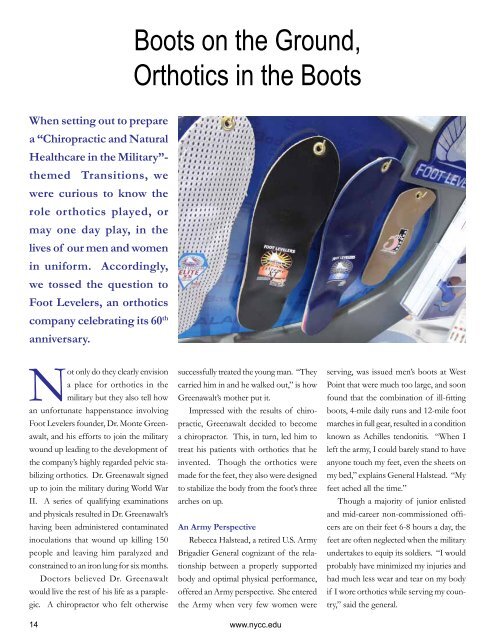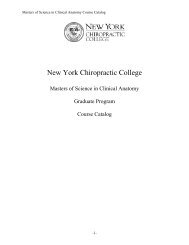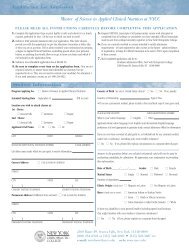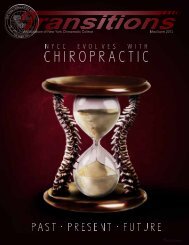July - August 2012 (PDF Version) - New York Chiropractic College
July - August 2012 (PDF Version) - New York Chiropractic College
July - August 2012 (PDF Version) - New York Chiropractic College
Create successful ePaper yourself
Turn your PDF publications into a flip-book with our unique Google optimized e-Paper software.
Boots on the Ground,<br />
Orthotics in the Boots<br />
When setting out to prepare<br />
a “<strong>Chiropractic</strong> and Natural<br />
Healthcare in the Military”-<br />
themed Transitions, we<br />
were curious to know the<br />
role orthotics played, or<br />
may one day play, in the<br />
lives of our men and women<br />
in uniform. Accordingly,<br />
we tossed the question to<br />
Foot Levelers, an orthotics<br />
company celebrating its 60 th<br />
anniversary.<br />
Not only do they clearly envision<br />
a place for orthotics in the<br />
military but they also tell how<br />
an unfortunate happenstance involving<br />
Foot Levelers founder, Dr. Monte Greenawalt,<br />
and his efforts to join the military<br />
wound up leading to the development of<br />
the company’s highly regarded pelvic stabilizing<br />
orthotics. Dr. Greenawalt signed<br />
up to join the military during World War<br />
II. A series of qualifying examinations<br />
and physicals resulted in Dr. Greenawalt’s<br />
having been administered contaminated<br />
inoculations that wound up killing 150<br />
people and leaving him paralyzed and<br />
constrained to an iron lung for six months.<br />
Doctors believed Dr. Greenawalt<br />
would live the rest of his life as a paraplegic.<br />
A chiropractor who felt otherwise<br />
14<br />
successfully treated the young man. “They<br />
carried him in and he walked out,” is how<br />
Greenawalt’s mother put it.<br />
Impressed with the results of chiropractic,<br />
Greenawalt decided to become<br />
a chiropractor. This, in turn, led him to<br />
treat his patients with orthotics that he<br />
invented. Though the orthotics were<br />
made for the feet, they also were designed<br />
to stabilize the body from the foot’s three<br />
arches on up.<br />
An Army Perspective<br />
Rebecca Halstead, a retired U.S. Army<br />
Brigadier General cognizant of the relationship<br />
between a properly supported<br />
body and optimal physical performance,<br />
offered an Army perspective. She entered<br />
the Army when very few women were<br />
www.nycc.edu<br />
serving, was issued men’s boots at West<br />
Point that were much too large, and soon<br />
found that the combination of ill-fitting<br />
boots, 4-mile daily runs and 12-mile foot<br />
marches in full gear, resulted in a condition<br />
known as Achilles tendonitis. “When I<br />
left the army, I could barely stand to have<br />
anyone touch my feet, even the sheets on<br />
my bed,” explains General Halstead. “My<br />
feet ached all the time.”<br />
Though a majority of junior enlisted<br />
and mid-career non-commissioned officers<br />
are on their feet 6-8 hours a day, the<br />
feet are often neglected when the military<br />
undertakes to equip its soldiers. “I would<br />
probably have minimized my injuries and<br />
had much less wear and tear on my body<br />
if I wore orthotics while serving my country,”<br />
said the general.

















